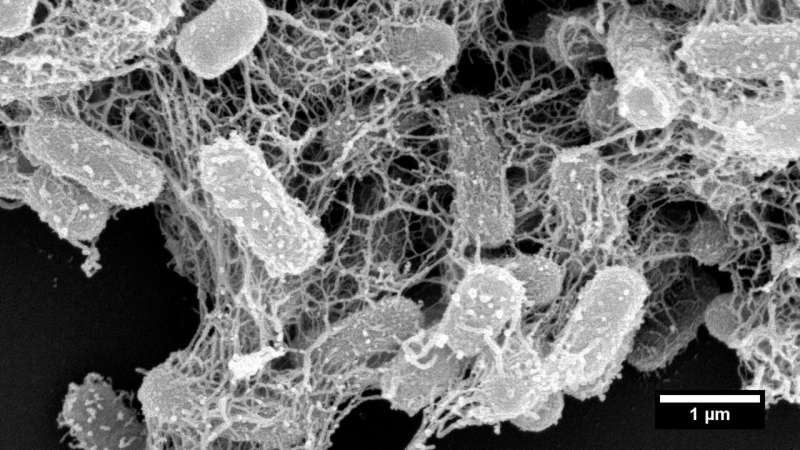
Nationwide College of Singapore (NUS) pharmaceutical scientists have developed artificial peptide nanonets for treating infections by micro organism strains proof against last-resort antibiotics.
In nature, trap-and-kill is a typical immune protection mechanism employed by numerous species, together with people. In response to the presence of pathogens, peptides are launched from host cells they usually promptly self-assemble in resolution to kind cross-linked nanonets, which then entrap the micro organism and render them extra susceptible to antimicrobial parts.
A number of analysis teams have explored artificial biomimetics of nanonets as an avenue for addressing the worldwide healthcare problem of widespread antibiotic resistance. Nonetheless, most distinguished research within the subject solely yielded disjointed quick nanofibrils restricted to the bacterial surfaces and are incapable of bodily immobilizing the micro organism. Moreover, these designs have been missing in management over the initiation of the self-assembly course of.
A analysis crew led by Affiliate Professor Rachel EE from the Division of Pharmacy, NUS has designed quick β-hairpin peptides of 15 to 16 residues which can be able to self-assembling into nanonets selectively in response to lipopolysaccharide or lipoteichoic acid, that are integral membrane parts distinctive to micro organism.

This specificity in the direction of micro organism is an interesting attribute not but achieved within the subject. The peptide nanonets displayed each trapping and antimicrobial killing functionalities, thus providing a direct improve from the trap-only nanonets in nature in addition to artificial designs reported within the subject. This opens up alternatives for modulating the exercise spectrum of the fabric.
The crew additional demonstrated purposeful tunability of the peptides, the place efficiency and fibrillation capability might be modulated by altering just one or two amino acids on the hairpin flip area of the sequences. Of curiosity, the nanonets displayed robustness towards enzymatic degradation by trypsin, which is a significant problem limiting scientific functions of straightforward antimicrobial peptides.
Organic evaluations of the peptide nanonets utilizing murine fashions confirmed important antimicrobial efficacy towards colistin-resistant micro organism and no systemic toxicity. This work was carried out in collaboration with Affiliate Professor Rajamani Lakshminarayanan who holds joint appointments with the Division of Pharmacy, NUS and the Singapore Eye Analysis Institute. These findings have been revealed in Superior Useful Supplies.
Prof Ee stated, “Our peptide-based nanonets have proven potentials in its place anti-infective technique to deal with antibiotic resistance. Our subsequent problem is to optimize the design for scientific software in people.”
In an ongoing effort to totally elucidate the capabilities of the peptide nanonets, the crew is investigating their potential in concurrently subduing inflammatory responses, a typical co-occurrence on the website of bacterial an infection.
Extra data:
Nhan Dai Thien Tram et al, Micro organism‐Responsive Self‐Meeting of Antimicrobial Peptide Nanonets for Entice‐and‐Kill of Antibiotic‐Resistant Strains, Superior Useful Supplies (2022). DOI: 10.1002/adfm.202210858
Supplied by
Nationwide College of Singapore
Quotation:
Trapping and killing superbugs with novel peptide ‘nanonets’ (2023, March 6)
retrieved 6 March 2023
from https://phys.org/information/2023-03-superbugs-peptide-nanonets.html
This doc is topic to copyright. Aside from any truthful dealing for the aim of personal research or analysis, no
half could also be reproduced with out the written permission. The content material is supplied for data functions solely.
